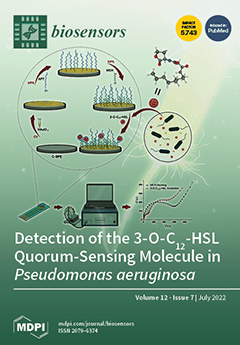This report describes the innovative application of high sensitivity Boron-doped nanocrystalline diamond microelectrodes for tracking small changes in Ca
2+ concentration due to binding to Annexin-A5 inserted into the lipid bilayer of liposomes (proteoliposomes), which could not be assessed using common Ca
2+
[...] Read more.
This report describes the innovative application of high sensitivity Boron-doped nanocrystalline diamond microelectrodes for tracking small changes in Ca
2+ concentration due to binding to Annexin-A5 inserted into the lipid bilayer of liposomes (proteoliposomes), which could not be assessed using common Ca
2+ selective electrodes. Dispensing proteoliposomes to an electrolyte containing 1 mM Ca
2+ resulted in a potential jump that decreased with time, reaching the baseline level after ~300 s, suggesting that Ca
2+ ions were incorporated into the vesicle compartment and were no longer detected by the microelectrode. This behavior was not observed when liposomes (vesicles without AnxA5) were dispensed in the presence of Ca
2+. The ion transport appears Ca
2+-selective, since dispensing proteoliposomes in the presence of Mg
2+ did not result in potential drop. The experimental conditions were adjusted to ensure an excess of Ca
2+, thus confirming that the potential reduction was not only due to the binding of Ca
2+ to AnxA5 but to the transfer of ions to the lumen of the proteoliposomes. Ca
2+ uptake stopped immediately after the addition of EDTA. Therefore, our data provide evidence of selective Ca
2+ transport into the proteoliposomes and support the possible function of AnxA5 as a hydrophilic pore once incorporated into lipid membrane, mediating the mineralization initiation process occurring in matrix vesicles.
Full article






